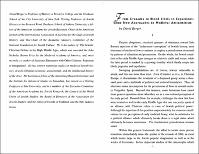Please use this identifier to cite or link to this item:
https://hdl.handle.net/20.500.12202/9285| Title: | From Crusades to Blood Libels to Expulsions: Some new approaches to Medieval antisemitism |
| Authors: | Berger, David |
| Keywords: | the Crusades Antisemitism --Europe --History. Jews --Europe --History. Jews --History --70-1789. Judaism --Relations --Christianity. |
| Issue Date: | 1997 |
| Publisher: | Touro College Graduate School of Jewish Studies |
| Citation: | Berger, D. (1997, March 16). From Crusades to Blood Libels to Expulsions: Some new approaches to Medieval antisemitism. In Second Annual Lecture of the Victor J. Selmanowitz Chair of Jewish History (pp. 1-29). Touro College. |
| Series/Report no.: | Bernard Revel Faculty Publications;1997 |
| Abstract: | Despite ubiquitous, ritualized gestures of obeisance toward Salo Baron's rejection of the "lachrymose conception" of Jewish history, most historians of medieval Jewry continue to employ a periodization structured by patterns of toleration and persecution. On the whole, the Jewish condition in the early Middle Ages emerges as relatively stable and secure, while the later period is marked by a growing hostility which finally erupts into libels, pogroms and expulsions.¶ Sweeping generalizations are, of course, always vulnerable to attack, and this one more than most. Even if limited, as it is, to Christian Europe, it characterizes the treatment of a dispersed group across a thousand years and a multitude of political and cultural boundaries. Thus, all observers make an exception for the persecution of Jews in seventh-century Visigothic Spain. Beyond this instance, some historians have raised more general questions about what they see as a rose-colored perception of the early period. Kenneth Stow, for example, challenges the view that Jews were treated so well in the early Middle Ages that one can justly speak of an alliance with Christian rulers or even of Jewish political power.' Although his rejection of this position unquestionably has concrete ramifications for our perception of early medieval Jewry, what he substitutes for a political alliance which ultimately breaks down is a legal status which ultimately becomes anomalous. The fundamental periodization remains intact. (from Introduction) |
| Description: | Proceedings of scholarly presentation (Touro College) |
| URI: | https://www.academia.edu/44322898/David_Berger_From_Crusades_to_Blood_Libels_to_Expulsions_Some_New_Approaches_to_Medieval_Antisemitism_Second_Annual_Lecture_of_the_Victor_J_Selmanowitz_Chair_of_Jewish_History_New_York_Touro_College_1997_1_29 https://hdl.handle.net/20.500.12202/9285 |
| Appears in Collections: | Bernard Revel Graduate School of Jewish Studies (BRGS): Faculty Publications |
Files in This Item:
| File | Description | Size | Format | |
|---|---|---|---|---|
| David_Berger_From_Crusades_to_Blood_Libel 1997 1-29.pdf | 1.94 MB | Adobe PDF |  View/Open |
This item is licensed under a Creative Commons License

